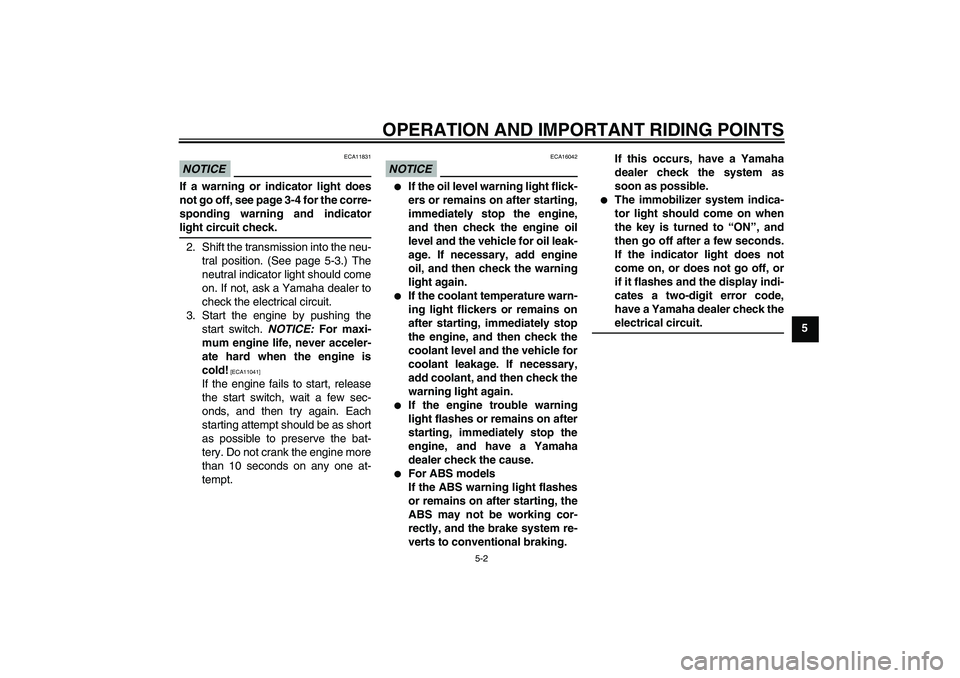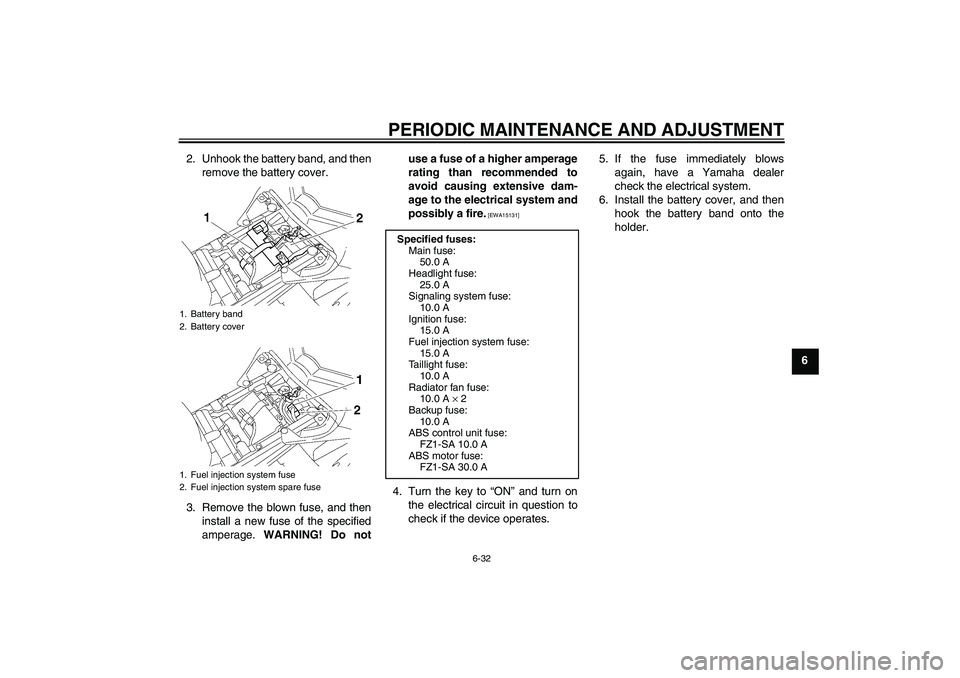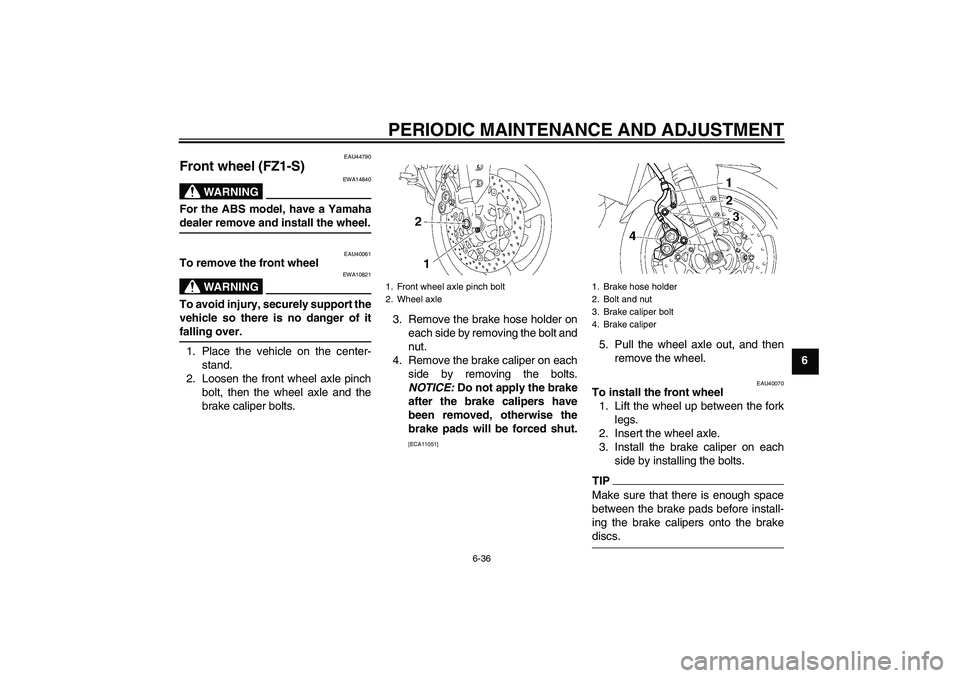Page 39 of 104

INSTRUMENT AND CONTROL FUNCTIONS
3-25
3
TIPTo obtain a precise adjustment, it is ad-
visable to check the actual total number
of clicks or turns of the damping force
adjusting mechanism. This adjustment
range may not exactly match the spec-
ifications listed due to small differencesin production.
WARNING
EWA10221
This shock absorber assembly con-
tains highly pressurized nitrogen
gas. Read and understand the fol-
lowing information before handling
the shock absorber assembly.�
Do not tamper with or attempt to
open the cylinder assembly.
�
Do not subject the shock ab-
sorber assembly to an open
flame or other high heat source.
This may cause the unit to ex-
plode due to excessive gas
pressure.
�
Do not deform or damage the
cylinder in any way. Cylinder
damage will result in poor
damping performance.
�
Do not dispose of a damaged or
worn-out shock absorber as-
sembly yourself. Take the shock
absorber assembly to a Yamahadealer for any service.
EAU15151
Luggage strap holders There is a luggage strap holder on each
passenger footrest.1. Luggage strap holder
U3C3E3E0.book Page 25 Thursday, July 10, 2008 2:03 PM
Page 46 of 104

OPERATION AND IMPORTANT RIDING POINTS
5-1
5
EAU15951
Read the Owner’s Manual carefully to
become familiar with all controls. If
there is a control or function you do not
understand, ask your Yamaha dealer.
WARNING
EWA10271
Failure to familiarize yourself with
the controls can lead to loss of con-
trol, which could cause an accidentor injury.
EAU45310
TIPThis model is equipped with a lean an-
gle sensor to stop the engine in case of
a turnover. To start the engine after a
turnover, be sure to turn the main
switch to “OFF” and then to “ON”. Fail-
ing to do so will prevent the engine from
starting even though the engine willcrank when pushing the start switch.
EAU44724
Starting the engine In order for the ignition circuit cut-off
system to enable starting, one of the
following conditions must be met.�
The transmission is in the neutral
position.
�
The transmission is in gear with
the clutch lever pulled and the sid-
estand up.
See page 3-27 for more informa-
tion.
1. Turn the key to “ON” and make
sure that the engine stop switch is
set to“”.
The following warning lights and
indicator light should come on for a
few seconds, then go off.�
Oil level warning light
�
Coolant temperature warning
light
�
Engine trouble warning light
�
ABS warning light (for ABS
models)
�
Immobilizer system indicator
light
U3C3E3E0.book Page 1 Thursday, July 10, 2008 2:03 PM
Page 47 of 104

OPERATION AND IMPORTANT RIDING POINTS
5-2
5
NOTICE
ECA11831
If a warning or indicator light does
not go off, see page 3-4 for the corre-
sponding warning and indicatorlight circuit check.
2. Shift the transmission into the neu-
tral position. (See page 5-3.) The
neutral indicator light should come
on. If not, ask a Yamaha dealer to
check the electrical circuit.
3. Start the engine by pushing the
start switch. NOTICE: For maxi-
mum engine life, never acceler-
ate hard when the engine is
cold!
[ECA11041]
If the engine fails to start, release
the start switch, wait a few sec-
onds, and then try again. Each
starting attempt should be as short
as possible to preserve the bat-
tery. Do not crank the engine more
than 10 seconds on any one at-
tempt.
NOTICE
ECA16042
�
If the oil level warning light flick-
ers or remains on after starting,
immediately stop the engine,
and then check the engine oil
level and the vehicle for oil leak-
age. If necessary, add engine
oil, and then check the warning
light again.
�
If the coolant temperature warn-
ing light flickers or remains on
after starting, immediately stop
the engine, and then check the
coolant level and the vehicle for
coolant leakage. If necessary,
add coolant, and then check the
warning light again.
�
If the engine trouble warning
light flashes or remains on after
starting, immediately stop the
engine, and have a Yamaha
dealer check the cause.
�
For ABS models
If the ABS warning light flashes
or remains on after starting, the
ABS may not be working cor-
rectly, and the brake system re-
verts to conventional braking.If this occurs, have a Yamaha
dealer check the system as
soon as possible.
�
The immobilizer system indica-
tor light should come on when
the key is turned to “ON”, and
then go off after a few seconds.
If the indicator light does not
come on, or does not go off, or
if it flashes and the display indi-
cates a two-digit error code,
have a Yamaha dealer check theelectrical circuit.
U3C3E3E0.book Page 2 Thursday, July 10, 2008 2:03 PM
Page 53 of 104

PERIODIC MAINTENANCE AND ADJUSTMENT
6-4
6
18Clutch lever pivot
shaftLubricate with lithium-soap-based
grease.√√√√√
19Shift pedal pivot
shaftLubricate with lithium-soap-based
grease.√√√√√
20Sidestand, center-
standCheck operation.
Lubricate.√√√√√
21*Sidestand switchCheck operation.√√√√√√
22*Front forkCheck operation and for oil leak-
age.√√√√
23*Shock absorber as-
semblyCheck operation and shock ab-
sorber for oil leakage.√√√√
24*Rear suspension re-
lay arm and con-
necting arm
pivoting pointsCheck operation.√√√√
25*Fuel injectionAdjust engine idling speed and
synchronization.√√√√√√
26 Engine oilChange.
Check oil level and vehicle for oil
leakage.√√√√√√
27Engine oil filter car-
tridgeReplace.√√√
28*Cooling systemCheck coolant level and vehicle
for coolant leakage.√√√√√
Change. Every 3 years
29*Front and rear brake
switchesCheck operation.√√√√√√ NO. ITEM CHECK OR MAINTENANCE JOBODOMETER READING
ANNUAL
CHECK 1000 km
(600 mi)10000 km
(6000 mi)20000 km
(12000 mi)30000 km
(18000 mi)40000 km
(24000 mi)
U3C3E3E0.book Page 4 Thursday, July 10, 2008 2:03 PM
Page 71 of 104

PERIODIC MAINTENANCE AND ADJUSTMENT
6-22
6
EAU43111
Checking the brake fluid level Front brake
Rear brake (FZ1-S)Rear brake (FZ1-SA)
Insufficient brake fluid may allow air to
enter the brake system, possibly caus-
ing it to become ineffective.
Before riding, check that the brake fluid
is above the minimum level mark and
replenish if necessary. A low brake fluid
level may indicate worn brake pads
and/or brake system leakage. If the
brake fluid level is low, be sure to check
the brake pads for wear and the brake
system for leakage.
TIPThe rear brake fluid reservoir is locatedbehind panel C. (See page 6-7.)
Observe these precautions:
�
When checking the fluid level,
make sure that the top of the brake
fluid reservoir is level.
�
Use only the recommended quality
brake fluid, otherwise the rubber
seals may deteriorate, causing
leakage and poor braking perfor-
mance.
�
Refill with the same type of brake
fluid. Mixing fluids may result in a
harmful chemical reaction and
lead to poor braking performance.
�
Be careful that water does not en-
ter the brake fluid reservoir when
refilling. Water will significantly
lower the boiling point of the fluid
and may result in vapor lock, and
dirt may clog the ABS hydraulic
unit valves.
�
Brake fluid may deteriorate paint-
ed surfaces or plastic parts. Al-
ways clean up spilled fluid
immediately.
1. Minimum level mark
1. Minimum level mark
1. Minimum level mark
Recommended brake fluid:
DOT 4
U3C3E3E0.book Page 22 Thursday, July 10, 2008 2:03 PM
Page 80 of 104
PERIODIC MAINTENANCE AND ADJUSTMENT
6-31
6FZ1-SA FZ1-S FZ1-SA
If a fuse is blown, replace it as follows.
TIPInclude steps 2 and 6 only for the fuelinjection system fuse.
1. Turn the key to “OFF” and turn off
the electrical circuit in question.
1. Main fuse
2. Fuse box
3. Fuel injection system fuse
4. Fuel injection system spare fuse
1. Fuse box
2. Ignition fuse
3. Signaling system fuse
4. Taillight fuse
5. Backup fuse (for odometer, clock and immo-
bilizer system)
6. Right radiator fan fuse
7. Left radiator fan fuse
8. Headlight fuse
9. Spare fuse
1. Ignition fuse
2. Signaling system fuse
3. Taillight fuse
4. Backup fuse (for odometer, clock and immo-
bilizer system)
5. Right radiator fan fuse
6. Left radiator fan fuse
7. Spare fuse
8. ABS motor spare fuse
9. ABS control unit fuse
10.Headlight fuse
11.ABS motor fuse
U3C3E3E0.book Page 31 Thursday, July 10, 2008 2:03 PM
Page 81 of 104

PERIODIC MAINTENANCE AND ADJUSTMENT
6-32
6 2. Unhook the battery band, and then
remove the battery cover.
3. Remove the blown fuse, and then
install a new fuse of the specified
amperage. WARNING! Do notuse a fuse of a higher amperage
rating than recommended to
avoid causing extensive dam-
age to the electrical system and
possibly a fire.
[EWA15131]
4. Turn the key to “ON” and turn on
the electrical circuit in question to
check if the device operates.5. If the fuse immediately blows
again, have a Yamaha dealer
check the electrical system.
6. Install the battery cover, and then
hook the battery band onto the
holder.
1. Battery band
2. Battery cover
1. Fuel injection system fuse
2. Fuel injection system spare fuse
Specified fuses:
Main fuse:
50.0 A
Headlight fuse:
25.0 A
Signaling system fuse:
10.0 A
Ignition fuse:
15.0 A
Fuel injection system fuse:
15.0 A
Taillight fuse:
10.0 A
Radiator fan fuse:
10.0 A × 2
Backup fuse:
10.0 A
ABS control unit fuse:
FZ1-SA 10.0 A
ABS motor fuse:
FZ1-SA 30.0 A
U3C3E3E0.book Page 32 Thursday, July 10, 2008 2:03 PM
Page 85 of 104

PERIODIC MAINTENANCE AND ADJUSTMENT
6-36
6
EAU44790
Front wheel (FZ1-S)
WARNING
EWA14840
For the ABS model, have a Yamahadealer remove and install the wheel.
EAU40061
To remove the front wheel
WARNING
EWA10821
To avoid injury, securely support the
vehicle so there is no danger of itfalling over.
1. Place the vehicle on the center-
stand.
2. Loosen the front wheel axle pinch
bolt, then the wheel axle and the
brake caliper bolts.3. Remove the brake hose holder on
each side by removing the bolt and
nut.
4. Remove the brake caliper on each
side by removing the bolts.
NOTICE: Do not apply the brake
after the brake calipers have
been removed, otherwise the
brake pads will be forced shut.
[ECA11051]
5. Pull the wheel axle out, and then
remove the wheel.
EAU40070
To install the front wheel
1. Lift the wheel up between the fork
legs.
2. Insert the wheel axle.
3. Install the brake caliper on each
side by installing the bolts.TIPMake sure that there is enough space
between the brake pads before install-
ing the brake calipers onto the brakediscs.
1. Front wheel axle pinch bolt
2. Wheel axle
1. Brake hose holder
2. Bolt and nut
3. Brake caliper bolt
4. Brake caliper
U3C3E3E0.book Page 36 Thursday, July 10, 2008 2:03 PM